The DirectX 12 Performance Preview: AMD, NVIDIA, & Star Swarm
by Ryan Smith on February 6, 2015 2:00 PM EST- Posted in
- GPUs
- AMD
- Microsoft
- NVIDIA
- DirectX 12
DirectX 12 vs. Mantle, Power Consumption
Although the bulk of our coverage today is going to be focused on DirectX 12 versus DirectX 11, we also wanted to take a moment to also stop and look at DirectX 12 and how it compares to AMD’s Mantle. Mantle offers an interesting point of contrast being that it has been in beta longer than DirectX 12, but also due to the fact that it’s an even lower level API than DirectX 12. Since Mantle only needs to work on AMD’s GPUs and can be tweaked for AMD’s architectures, it offers AMD the chance to exploit their GPUs in a few additional ways that a common, cross-vendor API like DirectX 12 cannot.
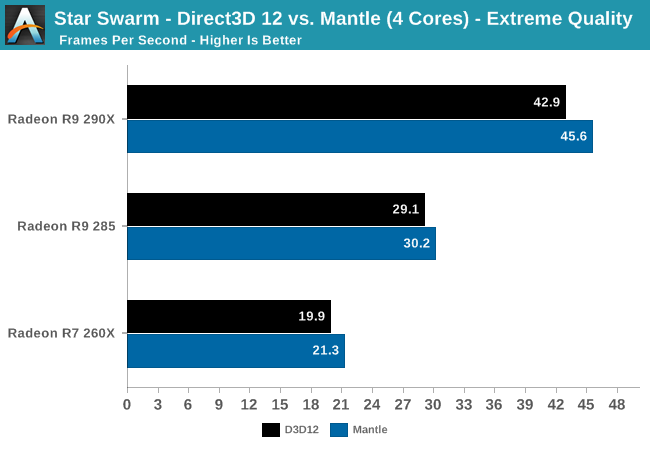
With 4 cores we find that AMD achieves better results with Mantle than DirectX 12 across the board. The gains are never very great – a few percent here and there – but they are consistent and just outside our window of variability for the Star Swarm benchmark. With such a small gain there are a number of factors that can possibly explain this outcome – better developed drivers, better developed application, further benefits of working with a known hardware platform – so we can’t credit any one factor. But it’s safe to say that at least in this one instance, at this time, Star Swarm’s Mantle rendering path produces even better results than its DirectX 12 path on AMD cards.
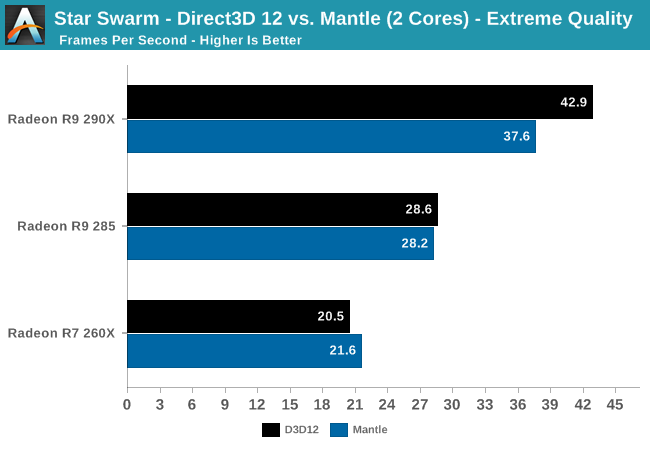
On the other hand, Mantle doesn’t seem to be able to accommodate a two-core situation as well, with the 290X seeing a small but distinct performance regression from switching to Mantle from DirectX 12. Though we didn’t have time to look at an AMD APU for this article, it would be interesting to see if this regression occurs on their 2M/4C parts as well as it does here; AMD is banking heavily on low-level APIs like Mantle to help level the CPU playing field with Intel, so if Mantle needs 4 CPU cores to fully spread its wings with faster cards, that might be a problem.

Diving deeper, we can see that part of the explanation for our Mantle performance regression may come from the batch submission process. DirectX 12 is unexpectedly well ahead of Mantle here, with batch submission taking on average a bit more than half as long as it does under Mantle. As batch submission times are highly correlated to CPU bottlenecking on Star Swarm, this would imply that DirectX 12 would bottleneck later than Mantle in this instance. That said, since we’re so strongly GPU-bound right now it’s not at all clear if either API would be CPU bottlenecked any time soon.
Update: Oxide Games has emailed us this evening with a bit more detail about what's going on under the hood, and why Mantle batch submission times are higher. When working with large numbers of very small batches, Star Swarm is capable of throwing enough work at the GPU such that the GPU's command processor becomes the bottleneck. For this reason the Mantle path includes an optimization routine for small batches (OptimizeSmallBatch=1), which trades GPU power for CPU power, doing a second pass on the batches in the CPU to combine some of them before submitting them to the GPU. This bypasses the command processor bottleneck, but it increases the amount of work the CPU needs to do (though note that in AMD's case, it's still several times faster than DX11).
This feature is enabled by default in our build, and by combining those small batches this is the likely reason that the Mantle path holds a slight performance edge over the DX12 path on our AMD cards. The tradeoff is that in a 2 core configuration, the extra CPU workload from the optimization pass is just enough to cause Star Swarm to start bottlenecking at the CPU again. For the time being this is a user-adjustable feature in Star Swarm, and Oxide notes that in any shipping game the small batch feature would likely be turned off by default on slower CPUs.
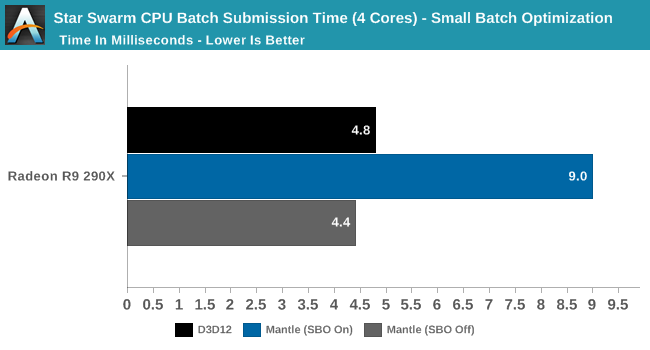
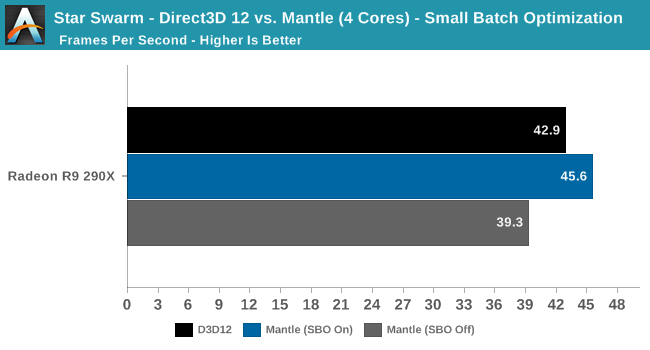
If we turn off the small batch optimization feature, what we find is that Mantle' s batch submission time drops nearly in half, to an average of 4.4ms. With the second pass removed, Mantle and DirectX 12 take roughly the same amount of time to submit batches in a single pass. However as Oxide noted, there is a performance hit; the Mantle rendering path's performance goes from being ahead of DirectX 12 to trailing it. So given sufficient CPU power to pay the price for batch optimization, it can have a signifcant impact (16%) on improving performance under Mantle.
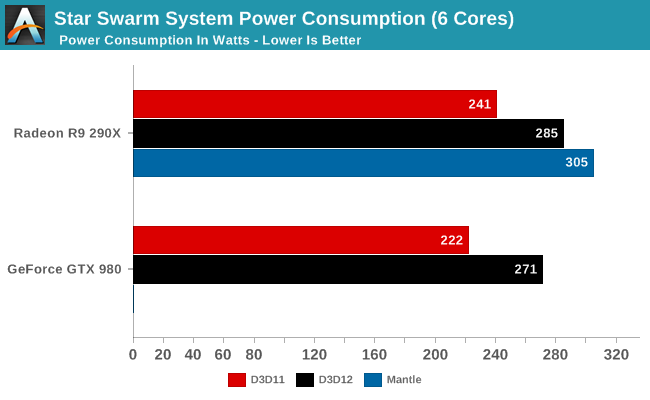
Finally, we wanted to take a quick look at power consumption among cards and APIs. To once again repeat what we said earlier, Star Swarm is an imperfect, non-deterministic benchmark, and coupled with the in-development status of DirectX 12 everything here is subject to change. However we thought this was interesting enough to include in our evaluation.
As expected, the increased throughput from DirectX 12 and Mantle drive up system power consumption. With the CPU no longer the bottleneck, the GPU never gets a chance to idle and video card power consumption ramps up to full load.










245 Comments
View All Comments
junky77 - Friday, February 6, 2015 - link
Looking at the CPU scaling graphs and CPU/GPU usage, it doesn't look like the situation in other games where CPU can be maxed out. It does seem like this engine and test might be really tailored for this specific case of DX12 and Mantle in a specific wayThe interesting thing is to understand whether the DX11 performance shown here is optimal. The CPU usage is way below max, even for the one core supposedly taking all the load. Something is bottlenecking the performance and it's not the number of cores, threads or clocks.
eRacer1 - Friday, February 6, 2015 - link
So the GTX 980 is using less power than the 290X while performing ~50% better, and somehow NVIDIA is the one with the problem here? The data is clear. The GTX 980 has a massive DX12 (and DX11) performance lead and performance/watt lead over 290X.The_Countess666 - Thursday, February 19, 2015 - link
it also costs twice as much.and this is the first time in roughly 4 generations that nvidia's managed to release a new generation first. it would be shocking is there wasn't a huge performance difference between AMD and nvidia at the moment.
bebimbap - Friday, February 6, 2015 - link
TDP and power consumption are not the same thing, but are relatedif i had to write a simple equation it would be something to the effect of
TDP(wasted heat) = (Power Consumption) X (process node coeff) X (temperature of silicon coeff) X (Architecture coeff)
so basically TDP or "wasted heat" is related to power consumption but not the same thing
Since they are on the same process node by the same foundry, the difference in TDP vs power consumed would be because of Nvidia currently has the more efficient architecture, and that also leads to their chips being cooler, both of which lead to less "wasted heat"
A perfect conductor would have 0 TDP and infinite power consumption.
Mr Perfect - Saturday, February 7, 2015 - link
Erm, I don't think you've got the right term there with TDP. TDP is not defined as "wasted heat", but as the typical power draw of the board. So if TDP for the GTX 980 is 165 watts, that just means that in normal gaming use it's drawing 165 watts.Besides, if a card is drawing 165watts, it's all going to become heat somewhere along the line. I'm not sure you can really decide how many of those watts are "wasted" and how many are actually doing "work".
Wwhat - Saturday, February 7, 2015 - link
No, he's right TDP means Thermal design power and defines the cooling a system needs to run at full power.Strunf - Saturday, February 7, 2015 - link
It's the same... if a GC draws 165W it needs a 165W cooler... do you see anything moving on your card exept the fans? no, so all power will be transformed into heat.wetwareinterface - Saturday, February 7, 2015 - link
no it's not the same. 165w tdp means the cooler has to dump 165w worth of heat.165w power draw means the card needs to have 165w of power available to it.
if the card draws 300w of power and has 200w of heat output that means the card is dumping 200w of that 300w into the cooler.
Strunf - Sunday, February 8, 2015 - link
It's impossible for the card to draw 300W and only output 200W of heat... unless of course now GC defy the laws of physics.grogi - Sunday, April 5, 2015 - link
What is it doing with the remaining 100W?